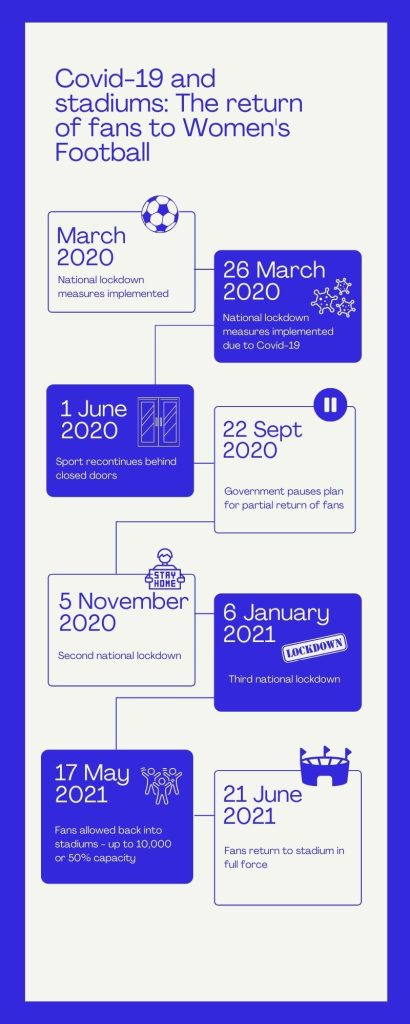Women’s Super League games are increasingly being played at men’s stadiums despite dwindling attendance.
The Barclays FA WSL have seen a recent drop in attendance of league games held at men’s stadiums from 2019 levels.
In 2019, the record attendance of a WSL game was over 38,000, whereas 2021 games played at men’s stadiums have drawn crowds of less than 10,000.
Aside from a few exhibition matches pre-2019, the FA started using men’s football facilities more for WSL season-openers in September 2019.
Over 30,000 travelled to the Etihad to see City’s defeat of United, whilst almost 25,000 attended Chelsea v Arsenal Stamford Bridge the next day in what Emma Hayes described as a win in “people’s consciousness”.
The exhibitions saw a huge 74,247 attend the 56 games, four of which were held at men’s Premier League and Championship grounds.
In the previous 2018/19 season, only 92,000 fans had attended league games over the season in total, according to reports by the BBC, with attendance averaged at 996 per game.

Retired WSL player Claire Rafferty said: “I think it is great to have a showcase event, such as a double header, that is maybe twice a season.
“In 2012 I played a double header and it was the first time I had experienced a bigger crowd than usual which made it more of an occasion.”
The 32-year-old pundit added: “Occasion is a great starting point to attract brand loyalty and be able to play on a big pitch.
“But in women’s football there’s not a lot of team loyalty, so for now it is about the atmosphere, creating and generating home fans, and having loyalty to the club.”
The phenomenon led to the creation of a Women’s Football Weekend later that year to coincide with the men’s international break.
Over this weekend in November 2019, the previously set record for attendance at a WSL game tumbled as a massive 38,262 turned up at Tottenham Hotspur’s to see Arsenal paint north London red, whilst elsewhere 23,500 visited the Merseyside derby.
Crowds across the board grew, as Chelsea Women saw a record-breaking 4,790 attend their ground, Kingsmeadow, to see the team’s 1-0 defeat of Manchester United.
A trickle-down effect was even seen in championship attendance which increased by 41% to an average of 440 in 2019, even after crowd-drawers Tottenham and Manchester City were promoted.
This was consistent even with smaller figures such as Villa Park’s 1,618 record at the 42,785-seater stadium, with this number larger than usual crowds at the Villa Ladies’ Trevor Brown Memorial Ground.
With coronavirus resulting in most of the previous season being played behind closed doors, WSL on the big stage was put on hold.
But, when it did return, in September of this year, it did so to quietened cheers.

The average attendance of the five season-openers, four of which were played at the homes of Tottenham, Everton, Brighton and Arsenal, was just under 4,800.
And whilst the 2019/20 season averaged more than 3,000 at league games at women’s grounds, the 2021/22 season is averaging at less than 2,300.
Rafferty, who now works for Chelsea FC’s commercial team, said: “One reason [attendance] has gone down is covid.
“In women’s football there is a focus on consistency and major tournaments help a lot domestically with the WSL.
“People are choosing when they go out – we need to make this, women’s football, the WSL, a top priority.”
Another reason for this stark contrast is that in 2019, WSL exhibitions were shown off the back of the July World Cup, in which a record-breaking 11.7m tuned into England Lionesses semi-final against USA, whereas 2021 followed a season behind closed doors.
Additionally, in the shadow of the coronavirus pandemic, and tainted by uncertainty about the return of fans, promotion regarding the match was released later than it had been in 2019.
There are some anomalies in the data such as 2019 attendances that were low, for example only 3,041 attended Brighton & Hove Albion’s Amex Stadium for their game against Bristol City.
Although Brighton are a strong team in the WSL, it’s possible that attendance is generally lower because their men’s teams and ground are less celebrated than others such as Arsenal’s Emirates or City’s Etihad.
And whilst the record attendance for WSL exhibitions in 2021, 8,705 for Arsenal vs Chelsea at Emirates on 5 September, represented a descent from 2019’s figures, it represents a small increase.
The argument for increasing exhibition WSL games at men’s stadiums is continuing to gain traction.
Advocates for the exhibitions say they help to create a one-club ethos, melding the identities of the two teams together whilst bringing fans across from the men’s game.

Lucy, 15, who plays for Chelsea Women FC’s U16 squad, said: “I do think that women’s teams should play at men’s stadiums as it encourages more people to come with both the capacity and the prestige.
“At women’s grounds the fans are a lot more devoted to their particular team whereas when you go to a larger men’s stadium the fans are more there for the occasion.
“I think it is important for women’s teams to have their own stadiums so that they can carve their own identity.”
The former AFC Wimbledon and Met Police player added: “It’s extremely inspiring and encouraging to see so many people becoming interested in women’s football and it makes the dream of becoming a professional women’s footballer that bit more desirable and exciting.”
The argument that the pitches and facilities cannot sustain both games financially or logistically impossible has been redundant.
Teams such as Reading Women who play at Madejski Stadium, Birmingham & Hove Albion Women who play at St Andrews’ and Leicester City Women who are playing most of their season’s games at King Power Stadium, are proving that men and women can share their pitches, and fans.
These larger stadiums are also more accessible than the majority of small grounds, with Arsenal Women’s ground Meadow Park being 12 miles from Emirates, Chelsea’s Kingsmeadow 7 miles from Stamford Bridge, and Manchester United’s Leigh Village not having a nearby train station.
Playing WSL games at men’s stadiums is helping to decrease the disparity in funding, conditions and prize money, and boosting the exposure, support, and awareness surrounding women’s football.
Currently, the showing of WSL games at men’s stadiums is on track to proportionally increase.
Arsenal are also set to play another WSL game at Emirates next March when they take on Tottenham, and recently played Barcelona in a Champions League game at Emirates, where they lost 4-0.
The FA Cup, which first attracted 45,423 to Wembley in 2018, repeated history this month as 40,942 sat under the iconic arch to watch Chelsea complete a domestic treble in their 3-0 defeat of Arsenal.

Arsenal WFC Chief Executive Vinai Venkatesham said: “We’re proud to be hosting WSL matches at Emirates Stadium and hope to see many fans join us.
“These games provide us with an exciting opportunity to showcase our world-class talent to more people than ever before; both through the matches at Emirates Stadium and also as a result of the new WSL broadcast deal.”
Featured image credit: Chris Lee, Chelsea FC via Getty Images




